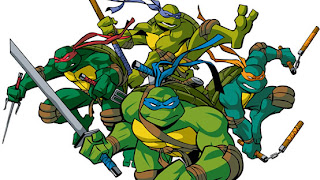I had been struggling for a while to come up with a convincing animal ninja, as the only examples come in the form of children's cartoons such as T.M.N.T. Because of this I have decided to steer away from a childish representation and aim my characters and story at a much more mature audience, giving me the opportunity to involve the real life violence that is associated with ninjas of the past.
I began research into the origin of the ninja to find out exactly what they were like, rather than relying on the generalised, stereotypical representation that we are shown in games and films today.
Origin of the
Ninja
It is difficult to pin down the emergence of the first
ninja, more properly called Shinobi. Japanese folklore states that the ninja descended from
a demon that was half man and half crow. However, it seems more likely that the
ninja slowly evolved as an opposing force to their upper-class contemporaries,
the Samurai,
in early feudal Japan .
Most sources indicate that the skills that became ‘Ninjutsu’, the ninja's art of
stealth, began to develop between 600-900 A.D.
Ninjas were regarded as ruthless as they were hired by Samurai
to do things such as assassinations, Planting misinformation, spying and
infiltration. These actions would go against a Samurai’s code of honor and so
to preserve their honor they hired those who were willing to do these deeds.
Where a Samurai would fight and die as a warrior, and be granted an ‘ honorable death’ on the battlefield, ninja’s will use any trick that is needed to ensure
their own survival.
Ninja Technique, Ninjutsu
Ninjutsu is practical; if a tactic is effective, then it is
acceptable. The Eight Methods taught in many Shinobi schools were: body skills,
karate, spear fighting, staff fighting, blade-throwing, use of fire and water,
fortification and strategy, and concealment.
Many ninja weapons were modified from farm sickles, saws for
wood cutting, pruning shears, etc. If discovered, these items would not give
away a ninja's identity. Among the ninja were expert poisoners. Poison was
added to food, or applied to a dart or blade. Some ninja disguised themselves
as flute-playing mystics. The sturdy flute could be used as a club or blow-dart
tube. These disguises were perfect for infiltration and assassination, and are
one of the reasons why ninja’s gained their infamous reputation of masters of
stealth and disguise.
Ninja’s in Battle
The stereotypical ninja we think of today, clad in black,
silently killing samurai guards and sneaking into the emperors’ bed chamber, is
more of a generalisation of the ninjas various uses and fighting styles.
During the 14th century, Japan had two separate imperial
courts, which battled for control of the country. The Northern
Court was controlled by the shoguns and the Southern Court
belonged to Emperor Go-Daigo, who wanted to rule in his own right. This was
known as the Nanbukucho wars. Ninjas were used heavily during these wars, infiltrating
enemy forts and tearing each court apart from the inside, and even burning down
the South's Hachiman-yama Fortress. The Southern Court eventually won and
Go-Daigo ruled the country as he wished.
About 70 years later, the Onin War broke out. Ninja featured
heavily in this conflict, as well. The war began as a succession fight within
the ruling Ashikaga clan, but soon devolved into a nation-wide civil war. Although
the Onin War ended after 10 years, it ushered in a century of turmoil called the
Sengoku Jidai, or ‘Warring States Period’ though it was actually ninja clans
fighting, rather than states.
This was the start of the ninja rivalry which drove ninja
clans to become more and more violent, and no mercy was shown when it came to
battles, as long as a single ninja remained of the apposing clan, the fighting
would continue.
The ninja were an important tool during the Sengoku Period,
but a destabilizing influence. When war-lord Oda Nobunaga emerged as the
strongest daimyo and began to reunite Japan during the 16th century,
he saw the ninja strongholds as a threat.
Nobunaga's lightning-quick attack on Iga forced the ninja to
fight open battles; they were defeated and scattered to nearby provinces or the
mountains of Kii.
While their power-base was destroyed, the ninja did not
vanish entirely. Some went into the service of Tokugawa Ieyasu, who later
became shogun in 1603.
The much-reduced ninja continued to serve both sides in
struggles. In one famous incident from 1600, a ninja sneaked through a group of
Tokugawa's defenders at Hataya castle, and planted the flag of the besieging
army high on the front gate!
The Edo Period 1603-1868 brought stability and peace to Japan , bringing
the ninja story to a close. Ninja skills and legends survived, though, and were
embellished to enliven the movies, games and comic books of today.


No comments:
Post a Comment